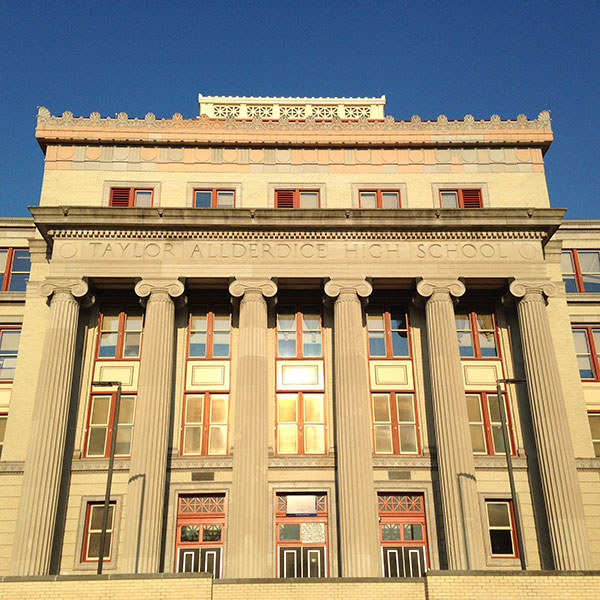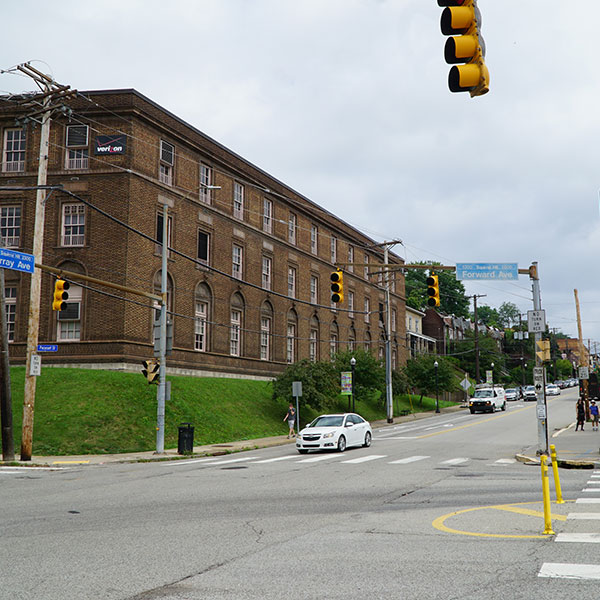
Opened in 2016 after a fire destroyed the original nature center on that site. Built by Pittsburgh Parks Conservancy in partnership with the City of Pittsburgh, the Center offers indoor and outdoor educational programs for all ages, has an explanatory nature walk and is a starting point to several delightful hiking/biking trails, including a fenced dog run, through Frick Park, Pittsburgh’s largest.

The current structure, designed by architect Edward Stotz, was built in 1911, replacing an 1870 one-story wooden schoolhouse on that site. A City of Pittsburgh Historic Structure, Colfax is also listed on the U.S. National Register of Historic Places. It is one of the most in-demand and academically successful public schools in Pittsburgh.

As another Beechwood Blvd. entrance to Frick Park, this is one of the most popular recreational venues for children (and adults) in Squirrel Hill and the eastern area of Pittsburgh. Adjacent to the slide is a large multi-equipment playground and, above it, a basketball court. This section also includes a baseball field, tennis court, and broad meadows for snow sliding, with access to the additional hiking/biking trails throughout the park.

“Keeping Tabs” is a public art installation at Community Day School, a Jewish day school serving children from age 3 through 8th grade. Over nearly a decade, CDS Middle School students collected six million aluminum soda pop tabs, memorializing the six million Jewish lives lost in the Holocaust. The sculpture consists of glass blocks, filled with those tabs, assembled into a mazelike Star of David that visitors can walk through.

With approximately 1,600 students, Allderdice High School is the largest of Pittsburgh’s public schools. Alumni include Pittsburgh mayors, authors, a Nobel Prize winner, and nominees of the Grammy, Tony, Emmy, and Academy Awards, professional athletes, business leaders, academics,
activists, and more.

The junction point of three key roads, this intersection bring motorists, pedestrians, and bicyclists through a key entrance to the Squirrel Hill neighborhood. Pocusset Street guides visitors into one of the major residential areas, while Forward and Murray Avenues guide them to and through major commercial and service establishments.

Murray Avenue, home to many of Squirrel Hill’s shops, restaurants, and other businesses, has been a major business district since 1893. The establishments on Murray reflect the neighborhood’s rich ethnic and cultural diversity, including a synagogue, a kosher and a general supermarket, a Peruvian clothing store and restaurants representing a wide range of international cuisines.

A parklet at the intersection of Murray and Phillips Avenues was established in honor of the late Pittsburgh City Councilman and Mayor, Bob O’Connor, who could often be found talking to constituents here. The Squirrel Hill Urban Coalition (SHUC) worked for over a decade to create this parklet – space for outdoor dining, socializing, and a connection to public transportation.

Neo-Grecian in architecture and dedicated in 1932, the Post Office contains a marble foyer showing the New Deal mural, “History of Squirrel Hill,” recognized as one of the neighborhood’s most significant treasures. Outside is a parklet with seating and greenspace developed under SHUC leadership. Across Murray Avenue is the Manor Theater, renovated in 2010-11. Like the Post Office, the Manor has been recognized as a significant neighborhood treasure.

As the Squirrel Hill Historical Society notes, this corner “is the heart of Squirrel Hill.” Epitomizing the neighborhood’s ethno-religious diversity are the nearby Jewish Community Center, the Church of the Redeemer, the Sixth Presbyterian Church, and the annual Lunar New Year parade and activities. Turning East on Forbes (and along both sides of the street) leads to the Squirrel Hill branch of Carnegie Libraries of Pittsburgh, two independent bookstores, coffee, ice cream and bike shops, a games store, and numerous international restaurants.

A Jewish outreach organization whose mission is to educate and inspire Jews of all ages, backgrounds, and affiliations. Staying on that sidewalk and turning right onto Beechwood soon offers views of the historic Smithfield and Homewood Cemeteries, popular venues for casual walkers and bicyclists. This sidewalk leads to Shaw Avenue and the High-Visibility Crosswalk for safe crossing of Beechwood and returning to FEC (H1).

Enter your email address to subscribe to our newsletter and receive notifications of new posts by email.
this is a test
this is a test